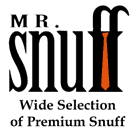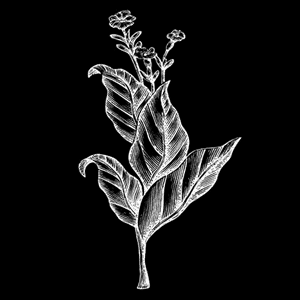
|
PAGES |
Types of Snuff Tobacco It is possible to place specific snuffs into broader categories, and it can be helpful to understand these categories when ordering snuff or when speaking with other snuff-takers. Each snuff is unique, and can differ greatly from other snuffs in the same broad category. These categories are not "official" or set-in-stone, and some snuff-takers would likely categorize them somewhat differently. But this is a good starting place. First we'll describe eleven broad categories and then a catch-all category. After that we'll discuss some of the attributes of snuff that make them so different.
Natural (or Plain) Snuff These snuffs have no scents, flavorings, or spices added to them. They depend on a very methodical selection and blending of tobaccos and the preparation of these tobaccos for the flavors that can be brought out in them. Far from being "plain," boring, or uniform in flavor, these snuffs can have an enormous complexity and richness, and can differ from one another widely. Depending on the amount of fermentation the tobacco undergoes, some of these snuffs have a "barnyard" scent. Examples:
Toasts Much like the plain snuffs,
toasts are usually made from
unscented tobacco. The difference
is a toasting process that brings out a
nutty, sometimes mildly woody or smokey
character in the snuff. Depending on
the tobacco and the process there may be a
slight sweetness that is brought out. Toasts are usually light in
color. The dry and finely
ground consistency of toasts can make
them somewhat difficult for the novice
snuff-taker to comfortably enjoy, but once
you have the technique down they are worth
it for their flavor and high nicotine
content. |
Within the Toast category are High Toasts, which typically include tobacco stalks and leaves and have all the moisture toasted out of them. High Toasts have more nicotine than Toasts, and deliver it very quickly. High Toasts are very similar to our next category, American Scotches. Examples:
| -Sir Walter Scott's Havana Toast |
| -Wilsons Irish High Toast #22 |
| -Toque Natural Toast |
| -Dholakia High Dry Toast |
| -Fribourg & Treyer (F&T) High Dry Toast |

American Scotches
American Scotches tend to be finely ground, dry, and they possess varying undertones of smoke and molasses. American Scotches fall into two basic categories: plain and sweet. Plain American Scotches tend to be much smokier, tend to be a litle more harsh, and are sometimes described as having a "BBQ scent." Sweet American Scotches are sweeter and a little easier to snuff than the plain variety. At some point in history, Americans began dipping their dry snuff in their mouth, and this continues to be a big part of how they are used. But, snuff-takers continue to use American Scotches as nasal snuff, though their extremely find grind can make them difficult to use comfortably. It takes a little practice to use them properly, but its worth it for their flavor and strength. It would be hard to tell the difference between some American Scotches and some High Toasts. Examples:
| -Navy Sweet |
| -Railroad Mills Plain |
| -W.E. Garrett Plain |
| -W.E. Garrett Sweet |
| -Honey Bee |
| -Tube Rose |

SP Snuff
There is a never-ending debate regarding what the initials "SP" signify. Though the most likely origin for the designation "S.P." is this particular theory. This type of snuff goes back to the early days of snuff in Europe. SP snuffs tend to be flavored with Bergamot and/or other citris flavors. Sometimes a hint of floral is included as well. This is a very popular snuff type, and as with other popular things, manufacturers have attempted to include snuffs in the SP category that are not truly traditional SP's. Snuff-takers tend to value their traditions, and a bergamot/citris scent is the key component to any SP snuff. Examples:
| -Wilsons of Sharrow Best SP |
| -Wilsons of Sharrow Grand Cairo |
| -Toque Original |
| -J&H Wilsons SP No1 |
| -Samuel Gawith No1 High Mill |
| -McChrystal's SP |
| -Abraxas St. Casura |

Floral Snuff
These snuffs tend to be perfumed snuffs and feature blends of such scents as geranium, lavender, lillac, rose, violet, and jasmine to name just a few. Some floral snuffs are very subtle and combine the floral scents with other influences. Other floral snuffs are much more direct and intense. These snuffs are more typical of the French influence in snuff-making. Examples:
| -McChrystal's Violet |
| -Fribourg & Treyer Kendal Brown |
| -Gawith Hoggarth Ambassador |
| -Wilsons of Sharrow Jockey Club |
| -Toque Lavender |

Gourmand Snuff
Gourmand (essentially, "food-related") snuffs are flavored/scented to be like any consumable delicacy, including foods, drinks, desserts. For this reason, this is a very wide and diverse category of snuff. Depending on who is making the list of categories, dessert snuffs, spice snuffs, and even fruit snuffs might fall into the Gourmand category. For this list, I've broken those three categories out on their own, and left the remaining food and drink flavored snuffs in the gourmand category. Examples:
| -Wilsons of Sharrow Apple |
| -Toque Cheese and Bacon |
| -FUBAR Shot of Rum |
| -Samuel Gawith SG Cola |
| -Gawith Hoggarth Almond |
| -Abraxas Cafe 11 |

Fruit Snuff
Fruit snuffs are, of course, flavored or scented with fruit. These can include banana, cherry, blueberry, and any other fruit of which youc an think. In some cases, fruit snuffs will have a little menthol or camphor added to give them a pleasent burn in the nose. This is especially true of German fruit snuffs. In reviews of fruit snuffs, snuff-takers will often comment positively if the fruit scent comes naturally, without any hints of being artificial. Examples:
| -Toque Peach |
| -McChrystal's Apricot |
| -Poschl Cherry |
| -Gawith Hoggarth Strawberry |
| -Samuel Gawith Raspberry |
| -Wilsons of Sharrow Summer Berry |

Spice/Mint Snuffs
There are a number of snuffs that are flavored/scented with spices or various mint flavors. A few are subtle, while most are very direct, straight-forward, and intense. Some focus on one particular spice or mint, while others mix several spices or even mint with spice. It is incredible how well some spice scents go with the natural scent of various tobaccos. Examples:
| -McChrystal's Annisette |
| -Wilsons of Sharrow Clove |
| -Abraxas Dragun |
| -Wilsons of Sharrow Crumbs of Comfort |
| -Gawith Hoggarth Cinnamon |
| -Dholakia Manjul |

Dessert Snuffs
Dessert snuffs attempt to capture the flavor/scent of sweet delicious desserts. These kinds of snuff succeed to varying degrees, some of them hinting at the flavor of their name-sake desserts, while others are like having the actual dessert in a snuff tin. As with fruit snuffs, snuff reviews of dessert snuffs focus on how "real" the snuff flavorings are, and anything leaning towards the "artificial" is usually called out. Examples:
| -Toque Christmas Pudding |
| -Wilsons of Sharrow Butterscotch |
| -Wow Apple Pie |
| -Samuel Gawith Toffee |

Schmalzler
Schmalzler Snuffs are traditionally German snuffs made of fermented Brazilian tobacco and flavored with sweet fruits or other sweet ingredients. Many have a date or fig-like scent to them. Traditionally they were moistened with animal fats, but modern Schmalzlers are moistened with oil. These snuffs are very moist, coarsely ground, somewhat fluffy, and rich in flavor. They are reminicent of an old-fashioned Christmas dessert. Schmalzlers tend to be fairly messy to use and, due to their course grind, can be difficult to keep in your nose. But they are worth it. Snuff-takers are especially drawn to Schmalzlers in the Fall and cold weather, and it is possible to use a large amount of Schmalzler snuff in a short amount of time. Examples:
| -Sternecker Echt Fresco Ungefettet |
| -Bernard Klostermischung |
| -Poschl Schmalzler Perlereuter |
| -Sternecker Staubinger |
| -Bernard Brasil Doppelt Fermentiert |
| -Poschl Schmalzler SF Sudfrucht |

Medicated Snuff
Medicated snuffs use menthol, eucalyptus, and/or camphor in their blends for flavor/scent and to produce a cooling/burning effect in the nose. Some medicated snuffs are simply tobacco blends with the cooling effect added. Other medicated snuffs combine the cooling effect with other flavors added to the tobacco, for instance fruit flavors. Examples:
| -McChrystals Original and Genuine |
| -Hedges L260 The Snuff |
| -Ozona Raspberry |
| -Silver Dollar Medicated |
| -Rosinski Berliner Luft |
| -Samuel Gawith Menthol Brown |

Complex and Unique
There are many amazing snuffs that are so complex or unique, that they do not fit clearly into one category or another. They may fit loosely into two or more categories, but they are impossible to really pin down. Examples:
| -De Kralingse St-Omer No.1 |
| -Abraxas Cerise Fire Cured |
| -Toque Spanish Gem |
| -De Kralingse Bon Bon |
| -Sir Walter Scott's Moro Moro Snuff |
Attributes of Snuff That Make them Different
Depending on the base tobacco used, how is prepared or fermented, the grind of the tobacco, how it is scented/flavored, and how it is aged, each snuff is a unique product with unique flavors and attributes. Below you'll find a description of some of the differences in snuff that are a result of the manufacturing process.
Base Tobacco and Blends
Tobacco is obviously the main ingredient in snuff, and for this reason the type of tobacco or tobaccos used to make the snuff has a big impact on the final product. Just to give you an idea of the various kinds of tobacco that can be used in making snuff, the following list is some of the varieties that were recently used by just one artisan snuff-maker here in the United States. Old Mill Artisan Snuff is no longer in production, but this illustrates the wide variety available to snuff-makers.
|
|
And these varieties of tobacco can be cured or prepared in different ways, bringing out different flavors in that particular variety. Some tobacco varieties are commonly subjected to one particular curing process, because of the resulting flavor. You can find more details about these processes elsewhere, but I wanted to share them here to give some idea of how tobacco is manipulated to create the amazing flavors/scents we find in snuff today.
-
Air-Cured
-
Fire-Cured
-
Flue-Cured
-
Sun-Cured
-
Toasted
Method of Scenting or Flavoring
Beside
the varieties of tobacco that can be used, or the
various curing processes they undergo, additional
flavors are added to some snuff products to create
even more amazing snuff flavors. Fruit
flavors/scents, spice flavors/scents, dessert
flavors/scents, food flavors/scents in general,
mint flavors/scents, floral scents, and other
exotic scents are added to the tobacco.
This is done in a number of ways. Sometimes
the tobacco is sauced or flavored when it is still
in leaf or cut form, and allowed to soak or rest
in the flavor solution. This flavor stays
with the tobacco through the rest of the
snuff-making process, including grinding.
In other cases, flavor/scent ingredients are added
to the tobacco after it has been ground.
Many snuff manufacturers have a standard tobacco
flour to which they then add flavoring to
create the final product. Creating an
amazing snuff is part art and part science.
Fermenting and Aging
The subject of fermentation is fairly complex. There were many different methods and recipes throughout the history of snuff, and each snuff manufacturer of course had its trade secrets. Some snuff products go though very little or no fermentation. Others go through a whole process of very carefully controlled fermentation in order to add flavor and increase the pungency of the snuff.
The
length of time of the fermentation can vary from a
very short time to years. Various salt
solutions and moisture are added, and sometimes
alkaline salts. The fermentation darkens the
color of the tobacco, and can sometimes add what
is called a "barnyard" scent to snuff.
Some snuffs are allowed to rest or age in barrels,
bringing out further complexity and flavor in the
tobacco. Some snuffs are allowed to age
after the grinding process either before packaging
or in packaging, in order to bring out their
finished flavor/scent.
Degree of Grinding
It is also possible to categorize snuff by the degree to which it is ground. When snuff-takers talk about snuff or post snuff reviews, they will often refer to fine-grind, medium-grind, or course-grind. They'll even break it down further into fine-medium, or medium-course at times. Traditionally, there are three categories of snuff grind, and typically certain types of snuff are usually ground to the same degree. Knowing the following grind terminlogy is useful, because it sometimes comes up in conversation between snuff-takers.
FIN - A very fine grind, usually very dry and tan in color. Most Toasts, High toasts, and American Scotches are ground in this way. Traditional, snuffs of this type are left unflavored or scented.
DEMI-GROS - Medium-fine to medium grind, and brown to golden-brown in color. These snuffs are neither dry nor moist, but do have some moisture or natural oils remaining. Most snuffs fall into this category. These are usually the easist to use, and are often recommended to beginners. Not all demi-gros snuffs are flavored or scented, but most of the SP, Floral, Gourmand, Fruit, Spice, Dessert, and some Natural snuffs are demi-gros.
GROS - A course grind, these are usually moist, and dark brown or almost black in color due to fermentation. Some Natural Snuffs and Schmalzlers are gros, and some of the older recipes for Complex and Unique snuffs.
Source of the Snuff
There are three types of places that snuff is manufactured. Any of the snuff types described above could potentially come from any of the following sources.
COMMERCIAL SNUFF MILL - This is the most common source for the snuff that snuff-taker's enjoy. Some of the companies making snuff have histories that stretch back over decades, and even centuries. Some snuff companies are fairly recent in their origin. Commercial snuff mills make fairly large quantities of snuff and make them available in shops, in their own on-line store, and in larger multi-brand on-line stores. Some of the snuff companies make fairly standard snuffs, while others specialize in rather complex snuffs made from traditional recipes. There is a wide variety of snuff available from commercial snuff mills and it is the easiest of the snuffs to acquire.
ARTISAN SNUFF MILL - Artisan snuff-makers tend to be fairly small operations, and focus on making some fairly elite and unique snuffs. While some artisan snuffs make their way onto multi-brand on-line stores, most artisan snuff mills focus on selling directly to their customers through their own on-line stores or personal contact through emails. Artisan snuff mills tend to be fairly innovative, and even experimental, in their snuff creations.
MADE AT HOME - It is possible to make your own snuff. Some do-it-yourself snuff-makers keep things fairly simple, while others commit a lot of time, study, and effort into creating what is essentially their own personal artisan snuffs. There is very little limitation to making your own snuff, as all of the methods and ingredients used by commercial and artisan snuff mills can be acquired by a private individual. The only real limitations are one's own industriousness and talent.
If you have any suggestions for this page or the categories and examples here, please feel free to click the button above. And don't forget to visit the Modern Snuff Blog and Facebook Group.
Modern Snuff © 2015, 2016, 2018, 2023 by Mark Stinson







